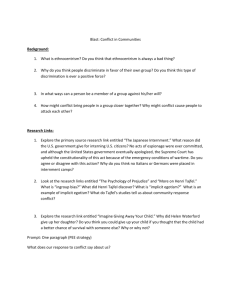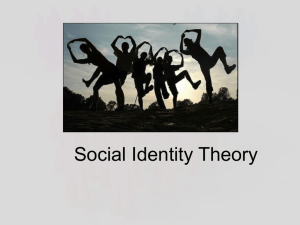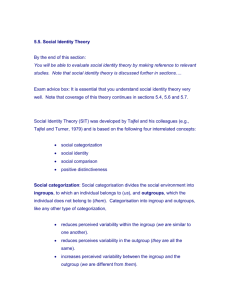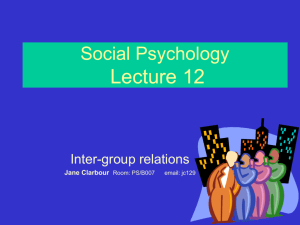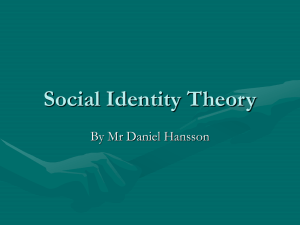ppt SIT 110303
advertisement
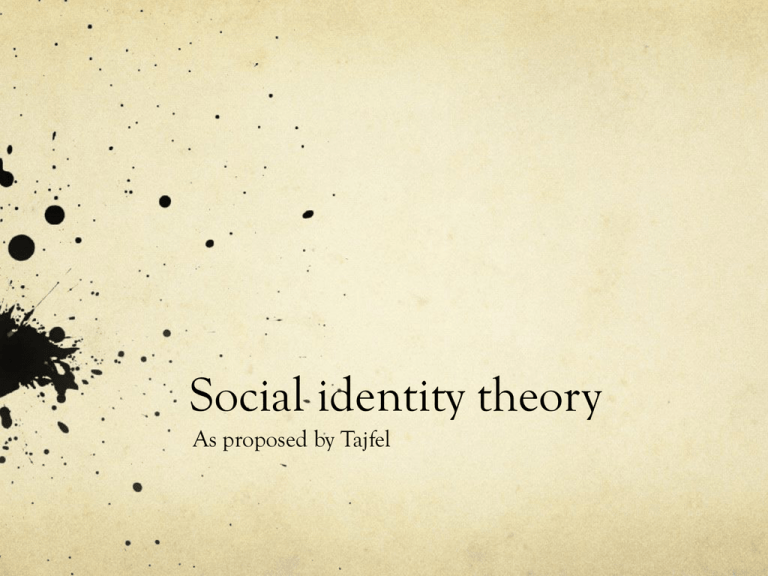
Social identity theory As proposed by Tajfel In Brief A person has not one “personal self” but rather several selves that corresponds to widening circles of group membership. Social identities Trigger individuals to think, feel and act on bases of group membership. “Social identity is the individual’s self-concept derived from perceived membership of social groups (Hogg and Vaughan, 2002) You act as representation of a group rather than yourself. Jane Elliot Research: Blue Eyes – Brown Eyes Five Steps to Tyranny - Step one "us and them" Research: Minimal group studies Turner and Tajfel showed that there mere act of individuals categorizing themselves as group members was sufficient to lead them to display ingroup favourism (1986) Eg. Studies on the minimal group paradigm (Kadinsky versus Klee experiment) when members of random groups were to divide points to in-groups vs. out-groups (Tajfel, 1971). These studies are reproduced and supported by many, but also critized. Perhaps the effects are due to demand characteristics (Hogg and Vaughan, 2008) – but on the other hand the minimal group effect can be obtained also when they did not know they were observed. Naturalistic observations has also shown the same (eg. Brown with wage negotiation in a British aircraft engineering factory). 3 fundamental psychological mechanisms underlying SIT SOCIAL CATEGORIZATION SOCIAL COMPARISON POSITIVE DISTINCTIVENESS SOCIAL CATEGORIZATION The cognitive process where objects, events and people are classified into categories. By doing this we tend to exaggerate the similarities in our group and exaggerate the differences to other groups. Social comparison We tend to compare our own social group to other groups. We distance ourselves from groups that does not share the same beliefs and ideas – and take more account of beliefs in our own. POSITIVE DISTINCTION The motivation to show that our ingroup is preferable to an outgroup. This is done by: • Ethnocentrism (“the ingroup-serving bias” – the group equivalent to SSB) • Ingroup favouritism • Stereotypical thinking • Conformity to ingroup norms. On top of this We seem to have a tendency to use group membership as a source of positive self esteem. Interestingly: the harder it is to leave a group, the more we compare our group with other lower status groups to boost our self esteem. So if we cannot leave a group we tend to believe the group is better than and others worse – than if we could (see dissonance theory) Liverpool vs United On the topic of soccer and SIT Breakwell (1978) studied teenage soccer fans, some of whom went to most games, whilst others did not go to games. Those who did not go to games were the most vehement about their loyalty and showed most in-group bias, presumably as they had a greater need to prove themselves as fans. Discuss: own examples of this. An evaluation of SIT STRENGTHS: - Starting with Tajfel’s pioneering minimal group studies, SIT has been supported by hundreds of relevant empirical studies. - SIT drew the distinction between personal identity and social identity and explored our basic need to belong. A new area at the time. - The orignial SIT theory has been expanding over the years and continues to generate a lot of research An evaluation of SIT WEAKNESSES • It describes but does not accurately predict human behaviour. Why is it that in some cases personal identiy is stronger than the group identity? • Can be accused of being reductionist if used isolated from other factors (e.g. cultural expectations, rewards as motivators) As with a lot of social research (see Zimbardo and Milgram for example) SIT was to favour situational explanations over dispositional ones when explaining groupmembers’ behaviour. Yet, some evidence shows that individual differences do make a change – competitive participants showed greater ingroup favouritism than cooperative participants for example (Platow, 1990) The self-esteem hypothesis, which figured extensively in the original statement is not seen as, as important any longer as it is shown to lead to short-lived effects on how in-group members see themselves (Rubin and Hewstone, 1998) You’ll hear more about SIT when we: In this level of analysis Discuss stereotypes Discuss conformity But also when we discuss: • Normality ideas and self-fulfilling prophesies/labelling in the Abnormal Option. • Health promotion (trying to predict who will change their behaviour) in the Health Option

